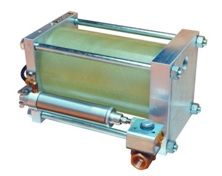Robo Drain Does More Than Just Draining Condensate…
Posted by AVP on Oct 4th 2022
Moisture is pervasive. There are small droplets that make their way into your air compressors regardless of whether you are aware of them or not. Air must be sufficiently dried for the system to function correctly before this moisture can be eliminated. It's not by chance that you just end up with a well-functioning HVAC system.
It's the result of careful preparation and upkeep. Our company firmly believes that an inefficient compressed air system leads to increased expenses per unit of compressed air, incorrect or unpredictable tool operation; decreased component life; lower capacity, and the buildup of rust and sludge in the main or branch lines. An incorrect method of condensate removal might result in a significant loss of compressed air (and energy).
Automated, high-pressure, zero-loss pneumatic Robo Drain valves do not require power. Saving money while also conserving air is the goal of this approach. For high-pressure compressor installations and numerous compressed air systems, this is the best option available today.
Why Choose Robo Drain?
When it comes to a drain that doesn't use compressed air, a zero-loss drain is what you're looking for. Robo Drains drain condensate as needed, allowing them to adapt to changes in the surrounding environment. If the temperature drops below a certain threshold, a heating element may be required to keep the drain from freezing.
In addition to its exact performance and great energy economy, zero-loss drains like Robo Drain are becoming increasingly popular. More and more plant managers are seeing the benefits of dependable drain solutions like these for cutting down on energy waste and creating more energy-efficient systems. This drain is more expensive upfront than a timed or manual drain, but in the majority of situations, it pays for itself within the first year of the purchase or even sooner.
Details Related To RD Installation
Condensate lines to the drain must always be positioned below the bottom of the vessel to be drained for the condensate to properly reach the RD reservoir. When condensate enters the reservoir, there must be a way for the reservoir's accumulated air to be released. The condensate will not be able to enter the reservoir if the air cannot be expelled.
Draining Condensate from the Air Conditioning System Is Essential
Compressed air systems' condensate drains may be the least attractive and most

underappreciated portion, but they are crucial nonetheless. It doesn't matter how much money you spend on a sophisticated compressed air system featuring a touch-screen monitor, variable-frequency drive, and strobe lights if you don't take a little time to make an informed decision about your drain.
Either the compressor intake or the system itself can introduce contaminants into the airflow of a system. Filters and separators remove grease, metal particles, corrosion, and pipe scale, but only if the drains are working correctly will the filters and separators be able to do their job.
How can drains help your systems run more efficiently? When it comes to drains, there are several ways in which they may either save or cost you energy, depending on how well they are maintained. They're essential if you want your system to run smoothly and reliably.
Over time, condensate that isn't flushed out of the system may accumulate, causing oil and water to accumulate and potentially freezing the system in the winter months. Premature wear and even catastrophic failure can occur with multiple-stage compressors because of moisture carried over from the intercooler into the subsequent stage.
There will be plenty of water downstream even if the temperature meter on your refrigerated dryer still reads 38F. In the event of a drain failure, a desiccant dryer may encounter considerable difficulties. Open drains can waste a significant amount of energy in some manufacturing facilities because of the friction they create.
The improper sort of drain, according to the experts at Air & Vacuum Process INC, can result in lost air, greater demand on staff to service faulty machinery, and significantly greater operating expenses.
For a completely optimized and cost-effective system, take into consideration the following elements:
Compressor capacity and operating conditions
The quantity of condensate created is determined by the ambient conditions and the capacity of the compressor. Additional drain output capacity will be required as the condensate volume increases. Condensate drain selection must take seasonal differences in the ambient environment into account when determining how to best manage temperature and humidity swings.
Since non-air-conditioned facilities often have higher summer humidity levels than winter ones, using a compressor in one of those places will result in a more humid environment year-round. Even in a mild environment, temperature and humidity fluctuate widely, affecting the amount of condensate produced. It's a good thing that we at Air & Vacuum Process INC provide tools to make it easier to determine the ideal drain size for your operation.
Contamination levels
Contamination levels are difficult to forecast, yet most operators know whether their systems are contaminated lightly or heavily. Compressed air can leak from the drain if the drain becomes clogged by the quantity of air and condensate pollution present in the air and condensate. By squandering pressurized air, failure to properly assess a drain's ability to manage impurities may be exceedingly expensive.
The pressure in the system
The choice of drain design is also influenced by the system pressure. Insufficient or excessive system pressure may cause the drain to malfunction. It is necessary to have specialized drain systems for vacuum applications in some cases.
The condensate control features in vacuum-operated pneumatic systems are more complex than those in systems that run at positive pressure. Here at Air & Vacuum Process, we have zero-loss RD drains that are particularly intended for these kinds of applications.
You must have a thorough grasp of your current working environment. For example, in some situations, the air is highly corrosive and the typical materials might be damaged by these components. Components made of stainless steel should be used while functioning in severely corrosive conditions.
We have a completely automated, zero-loss drain that doesn't require any power to use. We've got a wide selection of drains to pick from, so check out our website today!
